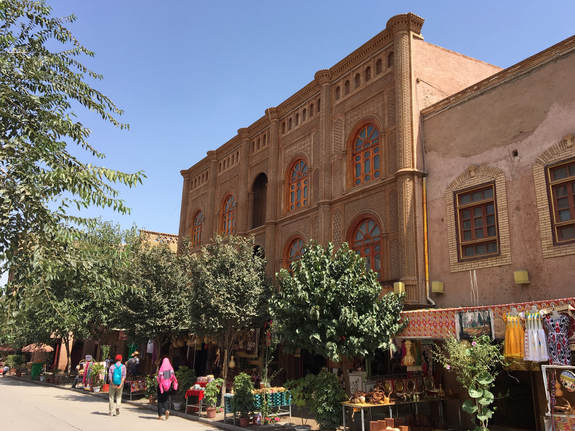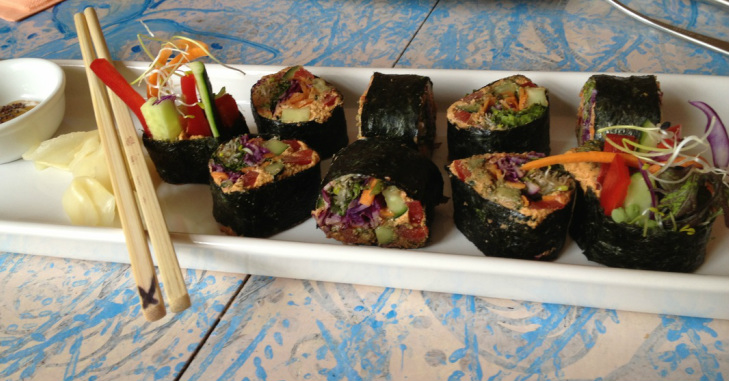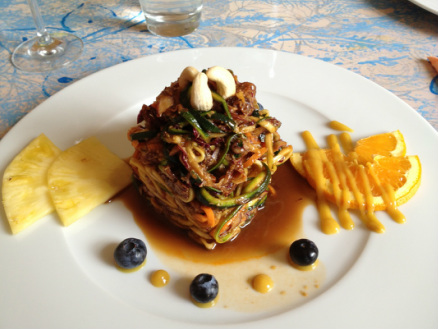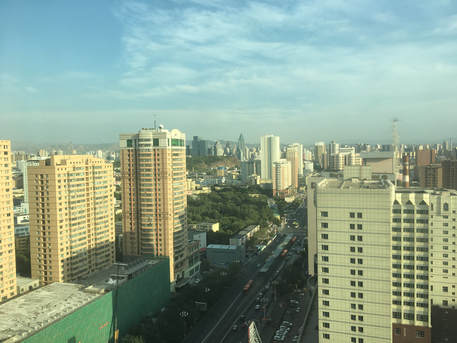 Urumqi, China: Qi Qi My Playmate...You're Not So Much Fun To Play Withby Randi / September 16, 2017
Urumqi, China: Qi Qi My Playmate...You're Not So Much Fun To Play Withby Randi / September 16, 2017Kashgar, China: A Vital Oasis on the Silk Road Both Then & Now
Related Posts

In Which I Go To Las Vegas On My Own Volition
First of all, the excessive cigarette smoking is ridiculous. It’s like mad scientists bottled up all the smoke ever smoked in the history of France, Spain, and Italy combined, and then emptied said bottle into an unventilated room, dooming everyone in that room to breathe the thousands of years of strangers’ used smoke in and out, in and out, over and over.
Secondly, the resorts are designed to keep you in, making it so difficult to get out that you’re forced to give up trying, rendering you an impotent, suddenly claustrophobic basketcase with heart palpitations. (During this last trip, it took me 45 minutes to find an exit out of the Caesars Casino & Forum Shops. At that point, I found an Exit door. This led me to an alley and parking garage behind the entire Caesars grounds, with absolutely nothing in sight but desolation and a highway. I could have walked a mile on the highway to get back to the Strip, but instead I was forced back inside that hellhole, for another hour of fun searching for an exit. What. The. Hell.)
Third, I don’t gamble. Or drink. So, yeah, Vegas is not for me.
However.
Thanks to Steve Wynn, I am willing to return to my version of hell. The famous casino magnate is now vegan, and he made damn sure that his casino’s restaurants were vegan-friendly. He overshot his mark though, because they are not vegan-friendly; they are vegan MECCAS. Despite the Wynn (and its companion hotel Encores, where many of the restaurants are located) being in Vegas, I’d go back. A lot. I KNOW!
For my first fancy dinner in Las Vegas, I made a reservation at Botero, an upscale, swanky restaurant with dim lighting. (Mostly just mentioning this to justify my photos.) The separate vegan menu offered a five-course dinner for $60. Considering the average entrée cost about $30 on its own, this deal was too good to pass up in this generally pricey place.
Soon after we were seated, our wonderful waiter Ramon brought us glasses of water.
(NB: Since this is my first restaurant review, I will explain a few things. I am always insanely thirsty, and I drink a lot of water. I always need water. Consequently, I always have to pee. Therefore, I will always try to comment on a restaurant’s speediness in bringing water to the table, and the quality of its bathrooms.)
Soon, he brought us a basket of assorted delicious breads and breadsticks. He made sure that it was only full of vegan options, and he even brought us a dish of Earth Balance butter before we could ask! The breads were warm, as all good bread should be, and we happily polished off the basket, not realizing just how much food was coming our way. I never learn.
Spring Onion Curry Soup
This creamy soup could easily have been too heavy, what with the hot weather and the curry flavoring, but the spring onion twist, and the crispy spinach accompanying the soup, lightened it. It was just the right level of comfort. A very good start.
Grilled Vegetable Arepas
Wow. Holy god wow. Ramon mentioned that the arepas were his favorite dish on the vegan menu, and he was right. They might be the best thing I ate during an entire week in Vegas. An incredibly thin, perfectly greasy cornmeal shell was stuffed with grilled vegetables, garlic aioli, and a huge chunk of avocado cooling it off. I could have eaten 1000 of these. I’d happily eat these every day. Just perfection. Wow. I want one right now!
Rice Flour Penne
By this point, I was starting to feel full. I pride myself on my usual ability to eat like that Japanese woman who set the hot dog record, so it really stinks when I falter on important stages. The next two courses were the entrees, and they were regular entrée-sized! However, champions push through. This pasta was nice, with some grilled broccoli and ‘tomato water’. I could have used more broccoli, and overall it was nothing special, but not bad.
Chicken Gardein
Steve Wynn apparently adores Gardein (with dern good reason), because it shows up on nearly all of his vegan menus. However, it was not just heated up and thrown on the plate like we do at home. This was cooked so well it seemed like a house delicacy. I definitely would not have recognized it as the faux meat I’ve had so often. It was perched atop grilled fingerling potatoes and smooth fava bean hummus. I admit, I could not finish the potatoes. So much food! But this was definitely a wonderful entrée. Gardein is amazing!
Blueberry Ginger Tart
My dining companion asked the waiter if she could substitute the chocolate mousse on the regular vegan menu for her dessert, because she is obsessed with chocolate and couldn’t fathom going without. The amazing Ramon of course made it possible, and I was happy to get to try another item. However, there was no comparison. I usually favor chocolate as well, but this blueberry ginger tart was impeccable. It was warm, covered with almond streusel and blueberry port reduction. And while blueberry and ginger is a pretty perfect combination, what always makes it even better? Lemon. Yup, the tart was complemented by a light lemon sorbet. Perfection. This was definitely in my top ten of restaurant desserts. Good job, Botero!
 Chocolate mousse, with raspberries & whipped cream
Chocolate mousse, with raspberries & whipped cream
Water speed: Great; refilled very frequently
Bathrooms: Clean and super fancy individual rooms; never had to wait
Service: Impeccable. Thanks Ramon!
Food: Overall, fantastic and recommended
Bonus: As we walked through the Wynn into Encores, trying to find the restaurant, we passed Brad, Angelina, and the entire Jolie-Pitt clan. And they were so friendly! I got to say hi to Zahara! Best ever!
For lunch one day, we trekked back to the Wynn to try the Terrace Point Café. Unfortunately, I somehow lost my food pictures, but I will do my best to describe what we ate.
Luckily, it wasn’t too busy when we arrived (boy it got busy!), and we got the prime table outside, adjacent to the staircase leading down to the pool. Beautiful! However, there were pigeons (I think; some kind of bird) surrounding us. One of them pooped about four inches from me, and our waiter promptly stepped in it before I could warn him. When I was in the bathroom, apparently a few were just sitting on our table! We were done eating at that point, luckily for us, because bird diseases.
Tempeh ‘Tuna’ Sandwich on wheat, $18
I don’t understand why this was $18. The tempeh tuna salad was nice, but I’ve made better 100 times. It was served on little circles of wheat bread with the crusts cut off, like two adorable tea sandwiches. It was good, and came with a little side salad, but it cost about 300% of what it should have. Really angered me, actually, especially because of the:
Wynn ‘Burger’ with Cheese, $9
This was pretty good, it came with fun accompaniments, and was half the price of the tempeh tuna! What is up with that? I recommend this one. The burger was mind-blowingly reminiscent of a cheap fast food cheeseburger, in the best possible way (meaning, tasted good and lacked the cow intestines and E. coli mixed in!). A Gardein patty with American soy cheese, ketchup, yellow mustard, pickles, and onions, it tasted just like a 99c special you’d get thrown to you in a drive through. Not only that, it was served with a bunch of quality thin-cut fries and a full-sized chocolate soy shake! So fun! Again, I ask you, why was this half the price of the two little circle tuna sandwiches? Steve? Anybody?
Terrace Point Cafe at the Wynn/Encores
Water speed: Good
Bathrooms: Clean, big, fancy
Service: OK; a few corporate looking groups came in and were more important than us
Food: Just OK, weirdly priced
Bonus: Pool-side table, chocolate shake
Anti-bonus: Bird poop
If you’ve looked into Las Vegas dining at all, you’ve probably heard of Sinatra. Tucked into the back corner of the Wynn/Encores complex, this restaurant is worth making time for. An old-fashioned, formal dining room with tablecloths, high seats, incredible food, and Frank’s Grammy, Emmy, and Oscar awards on display at the entrance, Sinatra was an almost-perfect dining experience.
We started with a basket full of warm Italian bread and breadsticks. The waiter brought me a dish of Earth Balance, which I was definitely starting to get used to! As usual, I ate an enormous amount of bread. It was good. Is there anything better than warm bread and EB? Hot damn.
 The lighting was so dim I swear!
The lighting was so dim I swear!
To start, I ordered the Estiva Salad. It was a pretty basic lettuce salad with cucumbers, avocado, tomatoes, black olives, and an oregano vinaigrette, for $17. It was just ok. The oregano vinaigrette was a little too tart for me, and the price seemed extravagant even at this very expensive restaurant.
Really, though, I think I was biased against my salad because one of my companions ordered the famous vegan Caesar salad and I realized I should have ordered the same. I should have ordered 4 of them. Oh my goodness. The ‘Insalatina dell’Imperatore’ ($14) was the best Caesar salad I’ve tasted in my entire life. No exaggeration. I loved the presentation, with the lettuce leaves just about halved, into big 4-inch pieces, stacked on top of each other, drenched in the most incredible lemon-caper Caesar this side of Rome, and topped with an enormous flat crouton. Obviously, this salad is the one to get, and not mine, despite the lure of avocado. Just wonderful.
Gardein Marsala
For my entrée, I ordered the Gardein Marsala with Gnocchi. There was no doubt in my mind that this was the way to go. With a good-sized Gardein Chick’n breast, cooked and breaded to perfection, covered with Marsala sauce and plenty of delicious forest mushrooms, this dish was heaven. The most heavenly part, as is expected in an Italian restaurant, was the perfect potato gnocchi accompanying the chicken. Gnocchi is good, but when it is done really, really well, it is an unparalleled treat, and this gnocchi was exceedingly well done. At $33, the dish was expensive, but it was so worth it. I definitely recommend it.
Lastly, for dessert, I ordered the Cioccolato, a bar of Valrhona chocolate mousse resembling a fancy Ding Dong (or Ho-Ho, or Twinkie, whichever one was brown), made with almond milk, topped with raspberries, and served alongside delicious chocolate sorbet. This was one of the richest desserts I can remember eating in recent memory, and it would have been hard to eat the whole thing, but I pushed. For you guys. You know on Project Runway when Heidi would say something looked so much more expensive than it was? This dessert tasted like what she meant. The chocolate was so rich, it seemed much more expensive than its $12 price.
Sinatra would have been one of my favorite dining experiences. Except…except for the smoke. Oh my god, the smoke. The restaurant’s location on the edge of the casino floor was one thing, with some smoke wafting in the front. But it was nothing compared to the outdoor patio behind the floor and adjacent to the restaurant. Every time someone went out or came in from this separate patio, clouds of smoke billowed into the dining room and negatively impacted our dining experience. It was such a shame, because every other part of the experience was near legendary. Our very kind waiter, seeing how drastically this was affecting our dinner, brought four or five free desserts to our table. (None of them were vegan; my dining companions said they were unbelievable, though.) The waiter did mention that most people complain about the smoke. I don’t know how the waiters themselves manage to work in such an environment! If they could figure out a solution to improve the air quality (which you would think they’d do, considering that people were trying to taste food here), this restaurant would be one of my favorites. If you think you can deal with this caveat, then I can recommend Sinatra to you.
Water speed: Solid
Bathrooms: Clean, fancy, very nice
Service: Great; very kind and understanding of the smoke situation
Food: Wonderful
Bonus: Grammy & Emmy & Oscar, oh my!
Anti-bonus: the smoke, of course.
I wish I had the time to try more restaurants at the Wynn! I look forward to hearing from more visitors as word spreads about how insanely vegan-friendly the casino is (and apparently the Mandalay Bay as well!).
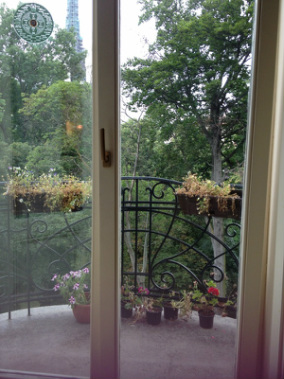
Zagreb Vegan Scene: The Art of Raw
 The view from our table at The Art of Raw. Fance.
The view from our table at The Art of Raw. Fance.
Maybe I’m inordinately impressed by raw food, maybe I was in awe of the owner’s previous, long-term experience at the famous & fancy Le Bec Fin in Philadelphia. Or maybe it was just incredible food, with incredible attention paid to everything. All of these considerations made this experience one of my all-time favorites.
The restaurant was a little tricky to find. It’s on the third floor in an apartment building, and you have to check the little name plates at the door to buzz in. Once inside, I loved the place. It felt like a shabby chic home, with the kitchen out in the open in the front room, and two comfortable, airy dining rooms off to the side. We were the first customers and chose a lovely table right in front of the open terrace.
Darko and his wife, Lena, own and run the place. Lena was also our server. They were both so kind and friendly. We talked a lot, especially with Darko about Philadelphia and raw restaurants in the USA.
Once we sat down, they brought a dish of cherries. If you haven’t heard, Zagreb is lousy with the stuff. No, seriously, the cherries I had in Croatia are the best I’ve ever had, so we devoured these quickly.
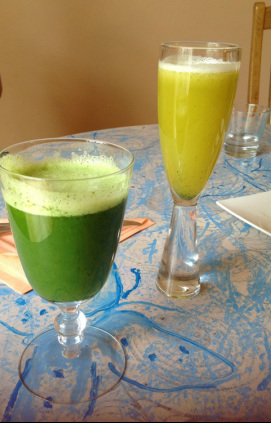 Mmm, juice. I mean mmm, noodle juice.
Mmm, juice. I mean mmm, noodle juice.
Lena also brought us a dish of fig carpaccio. This blew my mind. Thinly sliced fresh figs, covered in olive oil and salt and pepper. They did not taste like any figs I’ve ever had. Who would have thought of doing this? The oil and salt really softened the figs and they fell apart easily. The usually sweet figs were now savory and they were just wonderful. I love when novel but really simple concepts succeed with flying colors.
Just look at that detail! So many vegetables are stuffed in there. The sushi I’ve had recently (and frequently) in NYC is amazing but heavy, stuffed with fried tofu and grilled mushrooms and covered in heavy creamy sauces. This raw sushi was light and delicious and a welcome change of pace. I just loved it.
We were pretty stuffed, but of course we needed dessert. We ordered the torte, a creamy filling on a chocolate nut crust. It was pretty good, not too sweet which I liked. Strawberries filled the bottom half and flower petals were scattered in berry sauce. It was lovely.
 Raw superfood chocolate ice cream
Raw superfood chocolate ice cream
Overall, this was an amazing restaurant. I wish it was in a more convenient place for me, but it makes it a special destination spot. Darko and Lena are great people, and I hope you get to meet them.
The Art of Raw Food, Zagreb
- Water speed: Good; we were given big glass bottles to refill our glasses, which I always love
- Bathrooms: Fine, clean. A little weird that the sink is next to the dehydrator, but whatever – the toilet is separated!
- Service: Great
- Food: Wonderful. Go if you can!
- Bonus: Everyone was so friendly. We loved talking to them about Croatia, raw food, and America.


